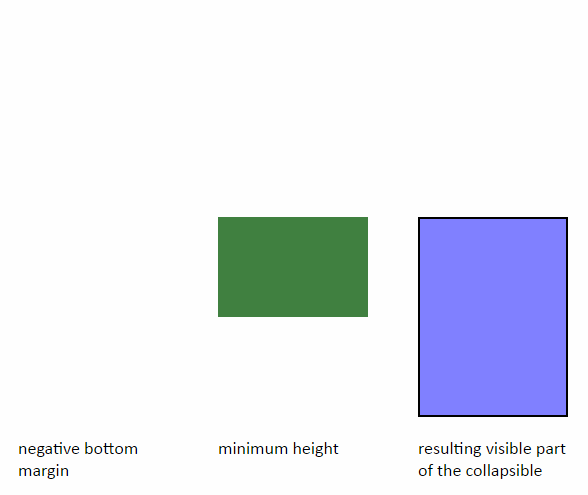这是一种从任何起始高度(包括0)过渡到自动(完整大小和灵活)的方式,而无需在每个节点上设置硬代码或初始化任何用户代码:https : //github.com/csuwildcat / transition-auto。我相信这基本上是您想要的圣杯-> http://codepen.io/csuwldcat/pen/kwsdF。只需将以下JS文件拍到您的页面中,然后要做的就是reveal=""从要扩展和收缩的节点中添加/删除单个布尔属性-- 。
一旦包含了示例代码下面的代码块,您需要做的就是这一切:
/*** Nothing out of the ordinary in your styles ***/
<style>
div {
height: 0;
overflow: hidden;
transition: height 1s;
}
</style>
/*** Just add and remove one attribute and transition to/from auto! ***/
<div>
I have tons of content and I am 0px in height you can't see me...
</div>
<div reveal>
I have tons of content and I am 0px in height you can't see me...
but now that you added the 'reveal' attribute,
I magically transitioned to full height!...
</div>
这是要包含在您的页面中的代码块,在此之后,所有内容都是肉汁:
将此JS文件放入您的页面中-Just Just™全部使用
/ *高度代码:自动;过渡* /
(function(doc){
/* feature detection for browsers that report different values for scrollHeight when an element's overflow is hidden vs visible (Firefox, IE) */
var test = doc.documentElement.appendChild(doc.createElement('x-reveal-test'));
test.innerHTML = '-';
test.style.cssText = 'display: block !important; height: 0px !important; padding: 0px !important; font-size: 0px !important; border-width: 0px !important; line-height: 1px !important; overflow: hidden !important;';
var scroll = test.scrollHeight || 2;
doc.documentElement.removeChild(test);
var loading = true,
numReg = /^([0-9]*\.?[0-9]*)(.*)/,
skipFrame = function(fn){
requestAnimationFrame(function(){
requestAnimationFrame(fn);
});
},
/* 2 out of 3 uses of this function are purely to work around Chrome's catastrophically busted implementation of auto value CSS transitioning */
revealFrame = function(el, state, height){
el.setAttribute('reveal-transition', 'frame');
el.style.height = height;
skipFrame(function(){
el.setAttribute('reveal-transition', state);
el.style.height = '';
});
},
transitionend = function(e){
var node = e.target;
if (node.hasAttribute('reveal')) {
if (node.getAttribute('reveal-transition') == 'running') revealFrame(node, 'complete', '');
}
else {
node.removeAttribute('reveal-transition');
node.style.height = '';
}
},
animationstart = function(e){
var node = e.target,
name = e.animationName;
if (name == 'reveal' || name == 'unreveal') {
if (loading) return revealFrame(node, 'complete', 'auto');
var style = getComputedStyle(node),
offset = (Number(style.paddingTop.match(numReg)[1])) +
(Number(style.paddingBottom.match(numReg)[1])) +
(Number(style.borderTopWidth.match(numReg)[1])) +
(Number(style.borderBottomWidth.match(numReg)[1]));
if (name == 'reveal'){
node.setAttribute('reveal-transition', 'running');
node.style.height = node.scrollHeight - (offset / scroll) + 'px';
}
else {
if (node.getAttribute('reveal-transition') == 'running') node.style.height = '';
else revealFrame(node, 'running', node.scrollHeight - offset + 'px');
}
}
};
doc.addEventListener('animationstart', animationstart, false);
doc.addEventListener('MSAnimationStart', animationstart, false);
doc.addEventListener('webkitAnimationStart', animationstart, false);
doc.addEventListener('transitionend', transitionend, false);
doc.addEventListener('MSTransitionEnd', transitionend, false);
doc.addEventListener('webkitTransitionEnd', transitionend, false);
/*
Batshit readyState/DOMContentLoaded code to dance around Webkit/Chrome animation auto-run weirdness on initial page load.
If they fixed their code, you could just check for if(doc.readyState != 'complete') in animationstart's if(loading) check
*/
if (document.readyState == 'complete') {
skipFrame(function(){
loading = false;
});
}
else document.addEventListener('DOMContentLoaded', function(e){
skipFrame(function(){
loading = false;
});
}, false);
/* Styles that allow for 'reveal' attribute triggers */
var styles = doc.createElement('style'),
t = 'transition: none; ',
au = 'animation: reveal 0.001s; ',
ar = 'animation: unreveal 0.001s; ',
clip = ' { from { opacity: 0; } to { opacity: 1; } }',
r = 'keyframes reveal' + clip,
u = 'keyframes unreveal' + clip;
styles.textContent = '[reveal] { -ms-'+ au + '-webkit-'+ au +'-moz-'+ au + au +'}' +
'[reveal-transition="frame"] { -ms-' + t + '-webkit-' + t + '-moz-' + t + t + 'height: auto; }' +
'[reveal-transition="complete"] { height: auto; }' +
'[reveal-transition]:not([reveal]) { -webkit-'+ ar +'-moz-'+ ar + ar +'}' +
'@-ms-' + r + '@-webkit-' + r + '@-moz-' + r + r +
'@-ms-' + u +'@-webkit-' + u + '@-moz-' + u + u;
doc.querySelector('head').appendChild(styles);
})(document);
/ *演示代码* /
document.addEventListener('click', function(e){
if (e.target.nodeName == 'BUTTON') {
var next = e.target.nextElementSibling;
next.hasAttribute('reveal') ? next.removeAttribute('reveal') : next.setAttribute('reveal', '');
}
}, false);

height:auto/max-height解决方案仅在您扩大的区域大于height您要限制的区域时才有效。如果你有一个max-height的300px,但组合框下拉菜单中,可以返回50px,则max-height不会帮你,50px是可变的,这取决于元件的数量,就可以到达一个不可能的情况下,我不能修复它,因为height不固定,height:auto是解决方案,但我不能与此使用过渡。